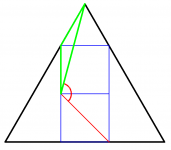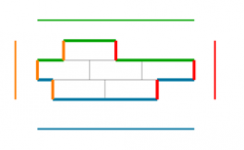The trick was to find this isocele triangle.
Then isocele triangle angles: 15° 150° 15°
180° - 45° - 15° ---> 120°
Then isocele triangle angles: 15° 150° 15°
180° - 45° - 15° ---> 120°
Last edited:
I would say wrong
I do not think so.
Attachments
I think, congruent means here that the bricks are not keyed exactly half way between layers.
Indeed, offsets do not change the result.
Indeed, offsets do not change the result.
The brick one is actually easy. 2H + 2L = 222
You have 6 exposed H and 6 exposed L so 6H + 6L = 666
Rather devilish, yes?
You have 6 exposed H and 6 exposed L so 6H + 6L = 666
Rather devilish, yes?
More questions on figure at post #1093An equilateral triangle and two squares. What's the angle?
1) What is the size of a square ? With respect to the triangle edge.
2) Instead of two squares; With one square, what is the size of the square ?
I think, congruent means here that the bricks are not keyed exactly half way between layers.
That would be incongruent. Congruent will always mean the same, in agreement, and/or like minded.
This agrees with the meaning of congruent I found:
1.
in agreement or harmony.
"the rules may not be congruent with the requirements of the law"
2.
GEOMETRY
(of figures) identical in form; coinciding exactly when superimposed.
"congruent" applied to the figure at post #1085 is confusing.
Indeed the bricks are identical. They are congruent.
However, the layers are offset not exactly half a brick, a lack of harmony. They are incongruent.
Well, too bad it was not simply said: bricks are identical in form.
Congruent has another meaning in maths about numbers.
1.
in agreement or harmony.
"the rules may not be congruent with the requirements of the law"
2.
GEOMETRY
(of figures) identical in form; coinciding exactly when superimposed.
"congruent" applied to the figure at post #1085 is confusing.
Indeed the bricks are identical. They are congruent.
However, the layers are offset not exactly half a brick, a lack of harmony. They are incongruent.
Well, too bad it was not simply said: bricks are identical in form.
Congruent has another meaning in maths about numbers.
More questions on figure at post #1093
1) What is the size of a square ? With respect to the triangle edge.
square edge = triangle edge / ((4/sqrt(3))+1)
2) Instead of two squares; With one square, what is the size of the square ?
square edge = triangle edge / ((2/sqrt(3))+1)
🙂
mchambin,
They were simply referring to the shape and size of the brick, independent of it placement. The placement would be referred to as the offset, stagger coursing or alignment.
They were simply referring to the shape and size of the brick, independent of it placement. The placement would be referred to as the offset, stagger coursing or alignment.
I did see a great science show on the telly yesterday, where 5 or 6 experts/scientists answer questions mailed in from the viewers.
One question was about siblings figthing over who got most lemonade when parents poured it into glasses.
The answer came as an experiment. Two glasses - some shape/size were filled with lemonade and then one glass was emptied to a differently shaped glass and kids had to say which glass contained mos lemonade.
They had all seen the whole process but younger kids (<7 yo) clamed that the bigger (narrower/higher) glass contained more of the drink ...
A child psychologist said that around 7-8 yo kids started to get an understanding of this and to get there was a process where their brains simply evolved.
If you have young kids, try this at home.
One question was about siblings figthing over who got most lemonade when parents poured it into glasses.
The answer came as an experiment. Two glasses - some shape/size were filled with lemonade and then one glass was emptied to a differently shaped glass and kids had to say which glass contained mos lemonade.
They had all seen the whole process but younger kids (<7 yo) clamed that the bigger (narrower/higher) glass contained more of the drink ...
A child psychologist said that around 7-8 yo kids started to get an understanding of this and to get there was a process where their brains simply evolved.
If you have young kids, try this at home.
999, later I will explain it.Here is one that many of you may have seen but if not, try your hand at it. If it's easy for you, hold off on answering other than to say 'Incorrect answer' to the others if that's the case. It's not that hard if your mind works that way.
I had a devil of a time the first go round.
Thank you.
Brilliant, you found better formulas than mines.square edge = triangle edge / ((4/sqrt(3))+1)
square edge = triangle edge / ((2/sqrt(3))+1)
🙂
There is a tan(75°) in my formulas.
Numerical results agree.
What is your approach.
Last edited:
square edge = triangle edge / ((4/sqrt(3))+1)
square edge = triangle edge / ((2/sqrt(3))+1)
🙂
Getting rid of tan(75°) that happens to be 2+sqrt(3), gives
square edge / triangle edge = (4*sqrt(3)-3)/13
=0.3021694792519622 😱
square edge / triangle edge = 2*sqrt(3)-3
=0.4641016151377545 😱
You were in Australia when you solved it?999, later I will explain it.
- Home
- Member Areas
- The Lounge
- Something to lighten the mood



